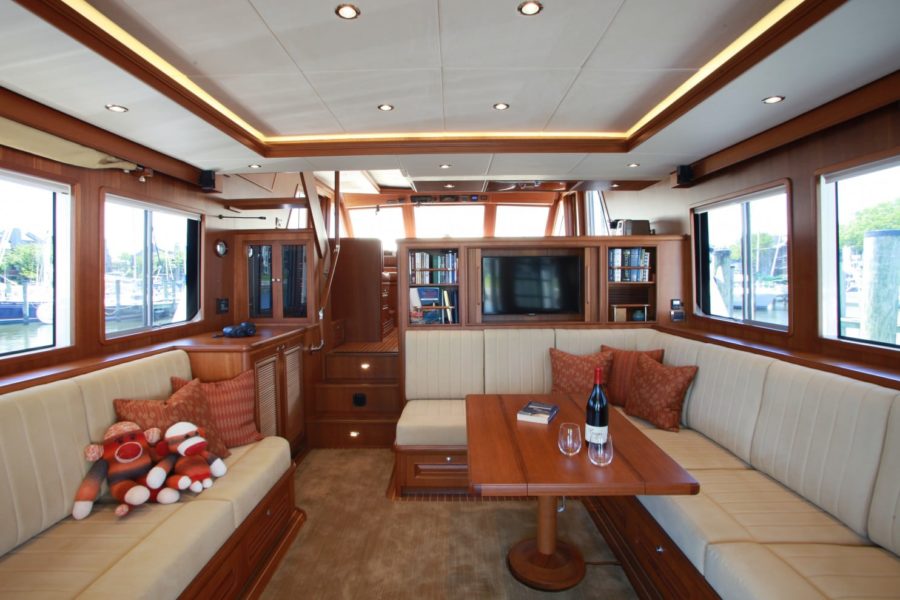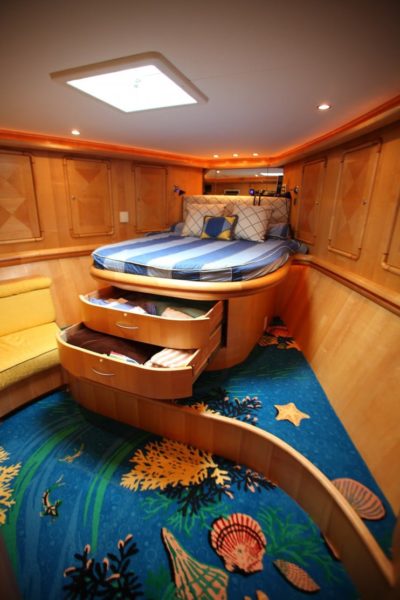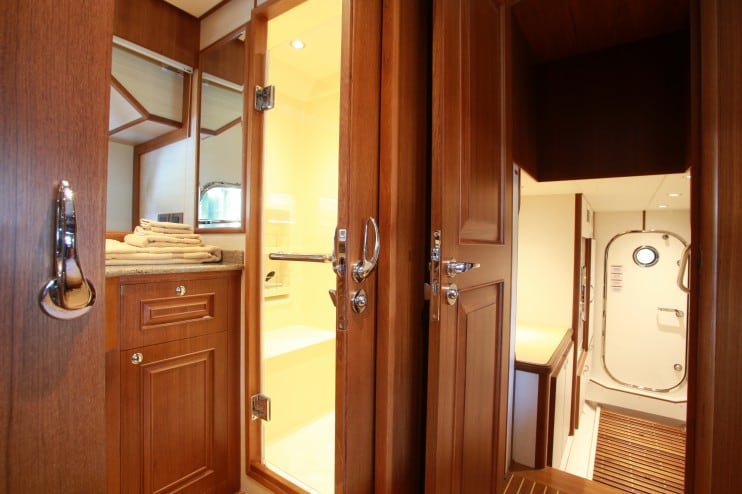Featured: The Washington Post: High design below decks on local yachts
Glamorous reputation aside, motor yachts are at once confining and liberating. Liberating because, of course, boat owners can charge off to just about anywhere there is water: Maine in summer, the Bahamas in winter.
The confining part is just as obvious: Short of the mega-yachts costing tens of millions of dollars (here’s to you, Dan Snyder and Michael Saylor!), most have serious space limitations. And then there are the other challenges, such as keeping dishes from flying around the kitchen.
The interior design of yachts exhibits the same yin and yang, as exemplified by several locally docked vessels. Modestly sized production boats — and even here we’re talking about models costing north of $300,000 — may come practically complete from the boatyard: built-in seating, standard galley, a specified configuration of cabins and baths and cabinetry. Sometimes a prospective buyer can pick the window coverings (curtains or shades) and the color of the hull (there’s a lot of navy blue out there on the water). Confining, perhaps, but there’s the freedom of not having to make a lot of decisions.
Production boats still may require pricey touches, however. After all, you can’t simply pick out a mattress off the sales floor at Sleepy’s. That’s where designers such as Christine Roney, of Yacht Interiors of Annapolis, come in. Roney began learning about boat design while in college as part of her major in interior design. She interned at and was hired by Yacht Interiors; 10 years later, she owns the company.
She and other boat experts know how to make a template for each bed and get a factory to make a mattress  to fit (a good queen-size can cost upward of $2,500, and many mattresses are hinged so they can be easily raised to access storage underneath). Boat decorators also know that bed linens start with commercially available flat sheets that are then cut and sewn in local workshops — such as the sheds found behind some Annapolis area houses.
to fit (a good queen-size can cost upward of $2,500, and many mattresses are hinged so they can be easily raised to access storage underneath). Boat decorators also know that bed linens start with commercially available flat sheets that are then cut and sewn in local workshops — such as the sheds found behind some Annapolis area houses.
If you step up to a custom creation, you don’t have to have built-in seating, though you might decide to, for practical reasons. In these boats, choices widen: Staterooms can be sited the way the owners want them — including amidship, to take advantage of the widest part of the lower deck. Pilothouses can be reconfigured for co-captains. And such yachts offer a chance to add more individual and luxurious flourishes: recessed lighting, granite countertops, teak paneling and custom-woven albeit water-resistant carpeting.
Yet even yacht owners with high-end fittings often say that boating is a simple lifestyle. That doesn’t necessarily mean an inexpensive one. Boat owners joke that they have learned to think in “boat units” of a thousand dollars here, a thousand dollars there. And you know what “boat” stands for, right? You got it: Break Out Another Thousand.
Happily for the pair, who have now been engaged for three years, the answer was a resounding yes — and the couple, who have a place in Rehoboth and one in Key West, Fla., live aboard Alchemy, their 55-foot-long, 16-foot-wide Hatteras 52 Cockpit Motor Yacht, from March to November.
Bill, who grew up in a Delaware manufacturing family, became sea-savvy as a submarine sailor. A nuclear engineer, he and his group built the USS Lapon, a Navy attack submarine, and “knew every bolt on it.” Managing the innards of Alchemy is no doubt a simpler affair.
Managing the aesthetics of Alchemy is important, too; for that the couple turned to Christine Roney of 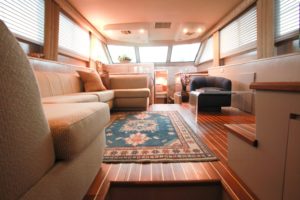 Yacht Interiors of Annapolis. Roney’s advice to Debbie, who likes things light and airy, was to keep the fabrics neutral “to keep colors flowing,” as Debbie puts it. But within the muted tans and dusty blues there is plenty of texture, including Debbie’s favorite grasscloth wallcovering on the galley and dining-area walls. (Adding a festive touch, artificial branches trimmed with tiny white lights enliven the wall behind the dining table.) Fabric-covered valances soften the boat’s windows, which are covered with custom-cut pleated shades.
Yacht Interiors of Annapolis. Roney’s advice to Debbie, who likes things light and airy, was to keep the fabrics neutral “to keep colors flowing,” as Debbie puts it. But within the muted tans and dusty blues there is plenty of texture, including Debbie’s favorite grasscloth wallcovering on the galley and dining-area walls. (Adding a festive touch, artificial branches trimmed with tiny white lights enliven the wall behind the dining table.) Fabric-covered valances soften the boat’s windows, which are covered with custom-cut pleated shades.
Alchemy, whose replacement value was recently pegged at more than $750,000, has a covered aft deck, a kind of rear porch; a tiny one-person galley two steps down from the salon, adjacent to a dining area with banquettes to seat four; a roomy flying bridge upstairs with raised bench seats in addition to the cockpit chairs (“so you can actually see something” while you’re sitting with the pilot, says Debbie); and three staterooms, all fitted with cushy places for curling up and reading or snoozing. Debbie, a professor of marketing at Salisbury University who is originally from Charleston, S.C., says the salon is her favorite room. The 12-by-12-foot space has the feel of a studio apartment, with aft deck and galley within sight, but with the luxury of more space below deck.
Bill and Debbie could have chosen freestanding furniture for the salon — such as the indoor-outdoor loveseat and chairs they have on the rear porch — but the built-in banquettes they opted for are more practical. The seating has storage space beneath and, thanks to medium-density polyurethane foam with a dacron wrap, the cushions don’t make you feel you’re perched atop a slab of unyielding wood.
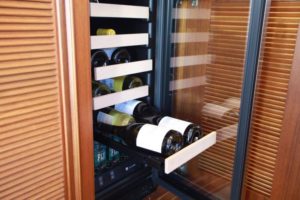 Built-ins are also simpler, a fact that appeals to Bill. People who don’t do boating, he says, don’t know it’s not only for the super-rich. It’s a simple, affordable lifestyle, one he has been happy with since his submarine days. Debbie explains that when they arrive in an area, they can pull up to a mooring ball, a type of buoy, and wait for the harbormaster to come around and collect the mooring fee (often about $35 a day). After that, it’s dinner aboard or a cellphone call to a water taxi to a local restaurant.
Built-ins are also simpler, a fact that appeals to Bill. People who don’t do boating, he says, don’t know it’s not only for the super-rich. It’s a simple, affordable lifestyle, one he has been happy with since his submarine days. Debbie explains that when they arrive in an area, they can pull up to a mooring ball, a type of buoy, and wait for the harbormaster to come around and collect the mooring fee (often about $35 a day). After that, it’s dinner aboard or a cellphone call to a water taxi to a local restaurant.
But there’s change afoot. Says Bill: “We had no intention of ever leaving this boat. But we went from ‘no thought’ to contract [on a new boat] in a week!” The new boat is a 58-foot Hatteras Long Range Cruiser, and it has a significant improvement over the current vessel: a walk-in engine room, meaning that Bill, in his late 60s, can make repairs without having to lift floor panels and shimmy around pumps. It also has a galley on the same level as the salon; Debbie is looking forward to this open-plan arrangement. Also, a larger boat will better accommodate their growing number of grandchildren. Last summer when it was so hot, Debbie says, the boat became something of a multi-generational water park, with everyone jumping off the flybridge and into the Chesapeake. A simple lifestyle and a refreshing one.
Yet life does seem simple aboard the Woodses’ Grand Banks Aleutian 53. A curated selection of clothing hangs in the “lockers” of the master stateroom; to limit fussing over bed linens, all the comforters are the same color and single-bed size — the big beds in the two main staterooms simply use two of them side by side, while the narrow beds in the bunk room can each get by with one.
Custom storage may sound complicated but in fact simplifies things: Eight wine glasses fit into a cabinet created for the purpose; bookshelves have “fiddles,” railings that prevent books from sliding out. A system, by the German decorative hardware company Häfele, of upright beechwood posts set into a pegboard-like base plate allows deep pot drawers to hold tight to stacks of dinner plates, coffee cups and bowls. (“We’re underway a lot,” Fiona says. “I don’t like things to be shifting.”) In another drawer, gleaming stainless-steel pots by the French company Cristel form a compact stack; they have an interchangeable, detachable handle.
Upper cabinets in the open galley seemed too deep; the solution was the Container Store’s rectangular pandan-leaf baskets. Fiona can pull out a basket to view the jars and tins of spices and condiments; filling each shelf with a whole row of baskets keeps everything secure. On the Jupiter’s “back porch,” the aft deck, thick seat cushions on the outdoor sofa and chairs snap down onto the frames.
The Woodses commissioned their 60-foot boat, which is lavished with teak paneling and cabinetry (“We don’t have any pillows with anchors on them,” says Fiona with a sly grin, “so teak seemed more boaty”). The custom order gave them the chance to choose which electronics and appliances and carpeting would be installed, plus Grand Banks offers the option of a coffered ceiling in the salon to accommodate recessed lighting (many boats have no overhead lights). Fiona had the recessed part of the ceiling lined with Ultrasuede to add a luxurious touch. They configured the master stateroom so that the master bath is larger than those in some houses. Overall, the boat has a grand, open feeling — three seating areas, upstairs and down — but also the warmth of a wood-paneled library.
The custom order also gave the Woodses an excuse to travel to Malaysia to “watch it being born,” Fiona says. They took delivery last October. Ordering such a boat today would cost in the neighborhood of $2 million, according to Grand Banks.
Most of the custom work was upstairs in the pilothouse, where the Woodses — he’s 66, she’s 49 — added a second door to the exterior, removed an extra table and specified two pilot chairs, side by side. That allows them to spell each other while spending hours at sea (“We’re cross-trained in everything but laundry,” Fiona says). The chairs themselves are not the usual tall, swiveling cockpit chairs. Rather, the seats are big and square like ottomans, upholstered in rich brown leather; by flipping each padded backrest forward or back, the sitter can see ahead to drive or face aft to join guests seated on a matching banquette, with a fold-out table between them. Everywhere on board handsome chrome fittings gleam. “Everything is beefier than it has to be,” Randy says.
Many of the boat’s neutral-color upholstery fabrics were chosen with the help of Nora Gugel of A La Mer in Fort Lauderdale, who would send the couple swatches wherever they were (“She’s the most efficient person we’ve ever met!” Randy says). For finishing touches — mattresses, refitted bedsheets and extra cushions — the Woodses called on Annapolis yacht decorator Christine Roney.
Streamlining the clothing and crockery aboard allows for redundancy of a more technical kind. Fastened down under the bed in the guest room is a whole set of propellers. “We need to be able to fix anything. We’re not ‘dock dwellers’; we cruise a lot,” Fiona says. That turns out to be an understatement: The couple put 24,000 nautical miles on their last boat over the course of a decade. And when dry land calls, there’s a pair of folding bikes stowed away, ready to roll.
Despite the carpeting by custom rug company Stark Carpet, despite the his-and-hers bathrooms, the 68-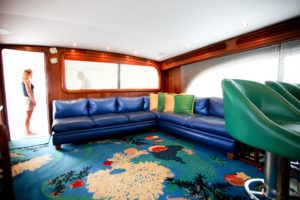 foot sportfishing yacht Extravaganza is “very much a family working boat, not a motor yacht or a houseboat,” says Suzanne Hillman, who owns the craft with her husband, David. “We really work it,” she says.
foot sportfishing yacht Extravaganza is “very much a family working boat, not a motor yacht or a houseboat,” says Suzanne Hillman, who owns the craft with her husband, David. “We really work it,” she says.
Although the Hillmans might cruise for a few weeks on the Chesapeake Bay in the spring and again in September, most of their time is spent deep-sea fishing — for yellowfin tuna, mahi-mahi, bluefish and flounder. Evenings find the family — Suzanne and David, plus a rotating cast of adult children and grandkids — dining on the catch and freezing what they can’t eat, processing it right onboard.
With its boat-top “spreaders” sending out long fishing lines, the boat can charge out to sea at 30 knots, its sharp V-shape hull rising out of the water and slicing through the waves. “When we’re in motion,” Suzanne says, “you have to have one hand holding on at all times.”
This is the Hillmans’ fourth boat, each bigger than the last. Extravaganza took four years to build, and it is the Hillmans’ third boat from Tiffany Yachts of Burgess, Va., a family firm at which only a few people work on each craft. “We really like working with them,” says Suzanne, who knows something about families, having been the eldest of seven growing up in Northwest Washington and Montgomery County. (Suzanne, now in her late 50s, went to Walt Whitman High School; David, in his early 70s, went to Bethesda-Chevy Chase.)
Years of boating meant the Hillmans also knew what they wanted. Because of the sharply raked sides of the hull, they put the master stateroom amidship, sideways, to take advantage of the 20-foot-wide beam of the boat. Adjacent and only slightly less wide are the his-and-hers bathrooms, separated by the shower they share.
The large guest stateroom is on a platform, built on a raised floor, again because of the hull. As with many boats, hanging lockers and drawers are built out from the sides, masking the curve of the wall.
For other decisions, the Hillmans turned to Washington designer Victor Shargai, who had decorated their McLean home.
They started with the carpeting. Suzanne wanted something that would be special and also take a beating. Shargai arranged for them to look through the archives at Stark Carpet, the custom-carpet maker. Together, they revised an old pattern that looks like the bottom of a fantastical sea, all shells and coral and sand dollars. Stark even made the carpeting not in wool but acrylic, which Suzanne says deals better with diesel fumes and saltwater.
The deep blue underfoot could make the salon feel dark, but the ceiling is dotted with recessed lights. The undulating patterns in the carpeting keep the eye moving so one doesn’t feel cramped.
While the U-shape banquette around the dining table continues the sea-bottom theme, the custom sofa in the salon is upholstered in blue pearlized leather, which stands up to sunscreen and frequent use as sleeping accommodations when there are more kids than bunk beds. Because the boat lifts up while speeding forward, there’s a counter above the galley sink to keep dishes from flying into the living area. The granite countertops are set on a honeycomb base to lessen the weight
Everything has been in full use since 2004, Suzanne says, and shows no signs of wear.
Ordering a 60-foot sportfisherman from Tiffany Yachts today would cost in the neighborhood of $3 million.
Suzanne’s Vienna-based company, Hillman & Glorioso, is a boutique public accounting firm specializing in tax litigation and, recently, mortgage fraud. David’s firm, Southern Management, which bills itself as the largest locally owned residential property management firm in the mid-Atlantic, owns about 25,000 apartments in the Washington area. Given the responsibility of these high-stress occupations, Suzanne says, the Hillmans, now married 29 years, find the time at sea to be “very cleansing.”
And even when it’s not cleansing, it’s fun — last Fourth of July, for instance, when Extravaganza played host to about 30 people. “We just had to make sure we had enough life jackets,” Suzanne says.
RESOURCES:
INTERIOR DESIGN: Yacht Interiors of Annapolis (Owner-Christine Roney),
yachtinteriorsofannapolis.com, Annapolis, Maryland | Story By: Nancy Mckeon
Source: The Washington Post Photos By: Matthew Girard

